#queerwolf writes
Text
I feel disgusting so clearly it is the hour of focus on character and story ideas to distract myself. I'm gonna talk about Hrafn and Gale some more and you can't stop me. Please interact if it interests you because I wanna talk about blorbo.
Contrast. Contrast is fun. They foil eachother in a lot of fun ways but this is less about foil and more about just, direct opposites that amuse me.
On the surface, wizard and sorcerer are opposites by default. Learned knowledge versus instinct. It makes them a fun dynamic to play with to begin with.
But Gale's a weird wizard. He talks about magic as, it's the way he sees and breathes and touches the world. It's an extension of his senses. That's not necessarily sorcerer-and-not-wizard stuff, because it's something he's kinda, he started with a gift and he honed it on purpose to experience that sensory extension more clearly. But he's a weirdly instinctive wizard and I love that about him. It's something I understand intimately - I am autistic and I was considered a musical prodigy, but it didn't mean I didn't have to learn things, I just learned things voraciously and a lot faster than others because music was how I understood emotion and sense and the shape of the world and I wanted always more of that.
And Hrafn's a weird, weird sorcerer. Especially for a wild magic one. His magic is totally instinctive and unrefined, but his approach to it is the direct opposite - he records the details of each wild magic surge and how it felt as it came on, every spell he can cast, it's all detailed like one enormous scientific study. He's trying to develop a greater understanding of the nuances of his magic so he can predict and refine and redirect it, even if he can't directly control What it does - the controlling what he can control when everything is Out of control approach (he's also a Dark Urge, or was, which definitely amplified this tendency). His components pouch, his journal, it's all Meticulously organised. And he practices alchemy because he can control every outcome and nuance of that branch of magic with study and practice. And it's almost a wizard-y approach to sorcery where Gale is in some ways a slightly sorcerer-flavoured wizard and that makes me very happy.
And no. Gale is not allowed to touch Hrafn's notes or his components or the alchemy kit. Hrafn is not allowed to touch Gale's notes or components or desk because he's more of the 'you tidied it and now I can't find ANYTHING'. When they live together it'll be like, they have a shared living area, but they're gonna have their own floors of the tower for their own workspaces because that's the only way they don't drive eachother mental. I love these idiots.
#oc: hrafn dekarios#queerwolf rambles#queerwolf writes#bg3 headcanons#bg3 oc#bg3 oc thoughts#my dark urge#dark urge x gale#gale headcanons#bg3 gale#gale dekarios#gale bg3#gale romance#bg3 fanfiction#gale x dark urge#gale x oc#gale x durge
14 notes
·
View notes
Text
Queerwolf By Night: Queercoding, Media Literacy, and Werewolf By Night
Okay, @bluemoonperegrine got me thinking about a thing, so it's time for Media Studies And Writing Hacks With Kat. Grab your beverage of choice, and let's talk about queercoding in Werewolf By Night.
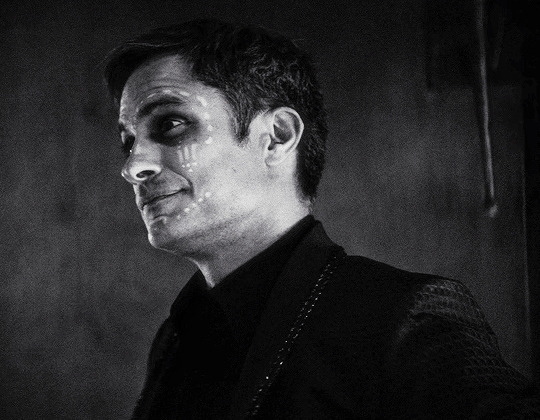
Let's start with a definition, because queercoding can sound like a conspiracy theory if you don't understand the context. In media studies, "coding" means using indirect means (usually details) to imply a state of being without explicitly stating that such a state exists. For example, if you're watching a TV show about a group of high-school friends, and one of the characters is consistently dressed in more expensive-looking clothes than the others, is more familiar with elite cultural signifiers like designer brands, and casually drops statements like, "Oh, yeah, I met him in the Hamptons last summer," then that character is being coded as wealthier than the others. Now, if a knowledgeable character SAYS, "Oh, that's Amelia, her family's rich," then it's not coding anymore. Amelia isn't wealthy-coded; she's just wealthy. Coding is only coding if the state of being is IMPLIED.
Now, why would anyone use coding when explicit statements are an option? Why can't people just say Amelia is rich? There are a number of reasons. First, maybe there isn't time or space to establish every single detail of a character through dialogue. Maybe Amelia's wealth is important to the story, but less important than the fact that she's dying of cancer, or in unrequited love with another character, or obsessed with rubber ducks. Or, second, maybe the coding is a setup for some kind of surprise or reversal. Maybe Amelia wears fancy clothes and has summered in the Hamptons, but surprise! Her parents just went to federal prison for fraud, and she's now penniless and sleeping on another character's couch, with no one mentioning it at first because it's painful for her.
And finally, there's arguably the most famous reason for using coding in media: because you literally can't be explicit about it. Let's talk about the Hays code.
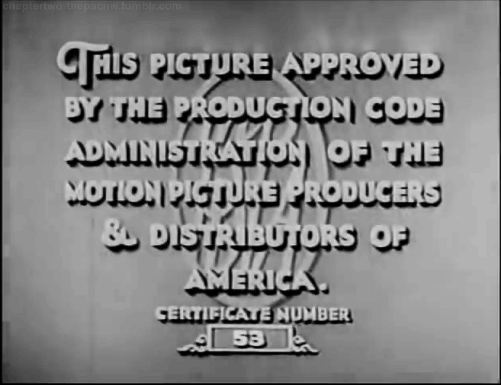
The Motion Picture Production Code, widely known as the Hays code, was a set of mostly self-imposed rules restricting the content of Hollywood movies between the 1930s and the 1960s. There was effectively a censorship board in charge of approving, disapproving, and demanding changes to films. The Code arose in response to a moral panic about sex and violence in movies; studios instituted the censorship board as a preemptive measure to head off possible censorship legislation. At the time, movies were such a new art form that there were serious concerns that First Amendment free-speech protections might not apply to them, so studios came up with this self-censorship system to avoid dealing with external censorship.
And what guidelines did they choose, you may ask?
Essentially, the guidelines were the conservative Catholic values of the 1930s. Yes, Catholic specifically; the man in charge was Catholic and talked a lot about how he applied his personal values to the task. So the Code included rules like a ban on insulting or denigrating religion or its institutions, among other things. There were also restrictions on what kind of crime and violence could be displayed, sex rules so strict that even married couples couldn't be shown in the same bed (if they even sat on a bed together, they had to keep at least one foot on the floor), and you KNOW there was a ban on anything gay. It was called "perversion" in the text of the code, but it meant gay stuff. Or trans stuff. Or kink. Or women being interested in sex. You get the idea.
But there was an exception to all these rules, and it was that more "objectionable" traits were allowed for villains. After all, a film isn't endorsing murder if the murderer goes to jail at the end and everyone stands around saying, "Wow, murder sure is terrible!" Right?
Yeah, what happened in practice was that filmmakers started giving villains and monsters traits that were stereotypically associated with queerness, supposedly to heighten how eeeeeevil these characters were, but actually for any number of other reasons. Apropos of absolutely nothing, here's Peter Lorre being extremely heterosexual with a cane in The Maltese Falcon.
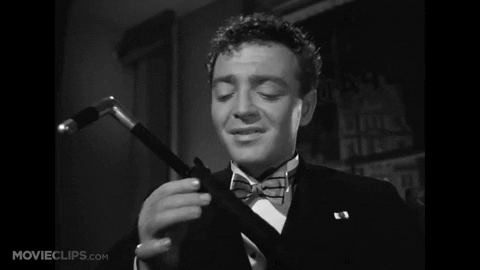
Now, how does this relate to WBN? Well, we all know WBN is an explicit love letter to 1930s and 1940s horror movies. If you don't believe me, here's Lon Chaney Jr. in 1940:
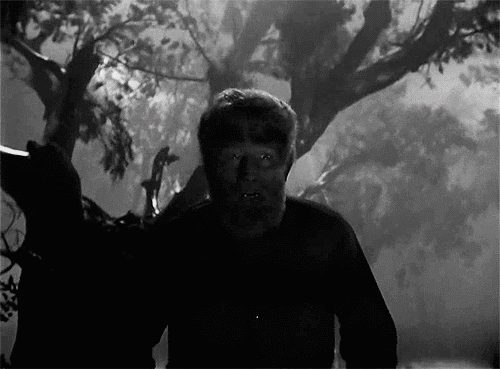
And here's Gael Garcia Bernal in 2022:

So let's talk about queercoding in classic Hollywood horror movies.
Obviously, confining queer material to villainous characters meant that monsters and their movies could be MUCH queerer than the rest of Hollywood's output. It also helped that horror filmmaking was full of extremely queer artists like James Whale, the openly gay director of Frankenstein. He's often brought up as an example of really obvious queercoding in horror cinema, especially in regard to his film Bride of Frankenstein, in which a young scientist is literally lured away from his impending marriage to a woman in order to create life with a VERY queercoded older man.
Look at these proud new dads.

And lest you think this is an outlier, let me introduce you to Dracula's Daughter, aka the Carmilla adaptation with no lesbian overtones, no sirree:

Yeah, queercoding is absolutely A Thing in classic Hollywood horror. It's part of why horror movies are as much of A Thing in gay culture as they are.
The Hays Code went away in the 1960s, partly due to the fact that Code compliance was SUPPOSED to be the one true path to wide distribution and profit, and yet the genderbending comedy Some Like It Hot made piles of money despite not being even CLOSE to Code-approved.
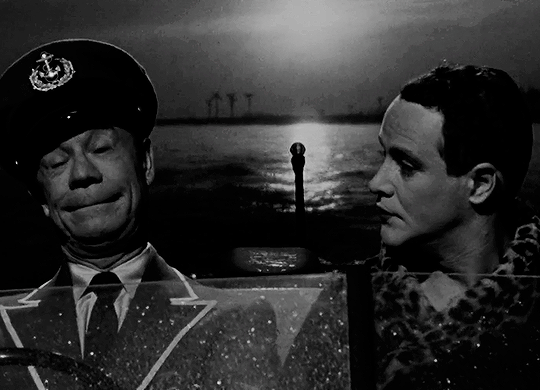
But 30 years is long enough to develop an entire cinematic language, and the legacy of the Hays Code lives on in things like queercoded Disney villains.

Now, let's talk about Werewolf By Night. A movie made under conditions not dissimilar to those of the Hays code in that Disney, for all its vaunting of First Gay Characters, absolutely refuses to put those characters in anything with wide distribution in such a way that they can't be edited out for Singapore.
So if your choices are 1) No Gay Stuff, 2) Easily Deleted Gay Stuff, and 3) Gobs and Gobs of Queercoding That Can't Be Removed, and you're making a retro black-and-white horror movie, you may find that option three makes the best, and queerest, movie. The cinematic language is all there for you, and you know at least some of your audience will pick up what you're putting down. And at this point, it's practically a genre expectation.
Now, I want to be clear about something: coding of any kind is, by its very nature, subject to interpretation. If we say something is queercoded, we are NOT saying that it's explicitly queer or that no heterosexual explanation exists or whatever. That's not how coding works. Queer theory and queercoding are a lens through which to look at a work. Sometimes queercoding is even unintentional; it's baked into so much American media by now that tropes like queer-coded villains sometimes happen not for particularly queer reasons but because an actor decided he wanted to sound like the villain in his favorite black-and-white movie. When I say WBN has queercoding, that is ALL I'm saying--that the coding is there. (And yes, I do realize this is the piss-on-the-poor website. Sigh.)
Queercoding is also not queerbaiting; the latter is where a piece of media deliberately builds up the expectation of expressly queer content and then refuses to deliver, often while mocking queer fans who fell for it. (Looking at you, Sherlock and Supernatural.) Queercoding may be used for queerbaiting, but the terms are not synonymous. Because WBN makes no queer promises (no romantic promises at all, really), it cannot be said to be queerbaiting.
So with all that in mind, let's look at coding in Werewolf By Night. And because he's the protagonist and everyone's favorite woobie, we'll start with Jack.
Look at this man. Enjoy him.

He will be the subject of Part Two.
#werewolf by night#queer theory#queer studies#werewolf by night meta#hays code#film history#long post#media studies and writing hacks with kat
38 notes
·
View notes
Photo

monstrwebseriesEpisode title reveals Day 2: Awarewolf
@monstrwebseries @thepickupbear@mfraimondi @timmers87@noahzark8261979
#monstrwebseries #monstr#monstrappwebseries #webseries#gaywebseries #queercreators#queerwebseries #gay #queer #lgbt#werewolf #therewolf #queerwolf#lgbtwebseries #dating #horror #screenplay#coverpage #screen #writing #gaymovie#gayfilm #keepfilminwa #awarewolf#crowdfunding #crowdfunded
#Monstrwebseries#monstr#monstrappwebseries#webseries#gaywebseries#queercreators#queer webseries#gay#queer#lgbt#werewolf#therewolf#queerwolf#lgbtwebseries#dating#horror#screenplay#cover page#screen#writing#gay movie#gay film#keepfilminwa#awarewolf#crowdfunding#crowdfunded
3 notes
·
View notes
Text
Updates and Changes
Hey all!
So, there’s been a change, that will affect our username after I finish posting this. Frankie (me - identifying that so I can use the royal I moving forward lol) decided to make a change to my username. “mugglerock” has been my username for twenty freakin’ years. It was created when I was deep in the Harry Potter fandom, and just randomly connected it to Fraggle Rock, lol.
Anyway, this decision did not come lightly, but the dickbag essays JK Transphobe wrote, and her hideous bigotry towards our beautiful trans and nonbinary friends, has left a bad taste in my mouth. I want to step away from associating myself with her bigotry, however inadvertently.
My new username is now connected to the ever developing social media for my writer pseudonym (I’m a year away from getting my MFA in creative fiction writing, holy shitballz). My tag line is: werewolves can be queer, too and so my usernames are all a variation on queerwolf. On tumblr, I’m now: @queerwolfsstuff. On Twitter: queerwolf_. And now, on Ao3: queerwerewolf.
And soon, this handle and our joint fic collection on Ao3 will be :the-real-anywolf!
On another fun note, we’ve definitely got more content coming, just going through the editing/beta process, to include our second Cockles fic, a choose your own ending fic, and so much more. And we’re both refreshing ourselves with the IAMD universe to get back to work on the sequel! (When the Mirror Shatters is currently 60k xD!).
Anyway, keep your eyes peeled for more fics!
36 notes
·
View notes
Photo

Episode title reveals Day 2: Awarewolf @monstrwebseries @thepickupbear @mfraimondi @timmers87 #monstrwebseries #monstr #monstrappwebseries #webseries #gaywebseries #queercreators #queerwebseries #gay #queer #lgbt #werewolf #therewolf #queerwolf #lgbtwebseries #dating #horror #screenplay #coverpage #screen #writing #gaymovie #gayfilm #keepfilminwa #awarewolf
#gaymovie#queerwolf#queercreators#dating#therewolf#screenplay#queer#werewolf#lgbtwebseries#gaywebseries#awarewolf#monstr#monstrappwebseries#coverpage#keepfilminwa#monstrwebseries#horror#lgbt#gay#webseries#screen#gayfilm#queerwebseries#writing
1 note
·
View note
Text
So this was MEANT to be a one-shot of a single night on the road with some conversation, some shit getting resolved and then some magic-y transition-y sex kinda stuff.
Unfortunately the blorbos are traumatised and I am an asexual hurt/comfort writer. That did not happen. Really, anybody could have predicted this.
But I don't want the work to disappear out of my drafts, because that would mean I have to do all the tags again and I hate tagging, so you get This bit on it's own for now so I stop trying to push myself to write it all before the drafts deadline because that is just Not gonna happen that is not how I work. You get one night on the road and a heartfelt conversation and it's half the length chapters usually are for me and OH WELL. Enjoy, I hope, and consider this a notification that I am still Working On Things and a sort of preview of the thing? idfk.
#queerwolf writes#gale bg3#gale romance#baldurs gate gale#baldurs gate 3 gale#bg3 gale#gale dekarios#gale x dark urge#gale x durge#bg3 fanfiction#bg3 fanfic idea#baldur's gate 3#baldur's gate 3 fanfiction#fanfic#bg3 dark urge#dark urge x gale#dark urge#the dark urge#gale baldurs gate 3#durge x gale#bg3 durge#durge#i don't actually know how to tag i just chuck everything i can think of at it and hope something's right
8 notes
·
View notes
Text
look i don't set out to write autistic characters on purpose. i do not intentionally infect the characters i fanfic about with autism like the werewolf i am definitely not. it just HAPPENS. I do not know enough about a neurotypical perspective to write one. if i write from their perspective at any point they tend to get the autism rizz it kinda just Works Like That. sorry. like it's not even self inserting it's that, this is how i see and experience and interact with the world i don't have clue how else to do it.
#queerwolf rambles#queerwolf writes#rhiannon was not supposed to be autistic#hrafn was not supposed to be autistic#i kinda liked autistic gale headcanons but did not really see him that way myself until I started writing him and it just Happened#OOPS. ALL AUTISTIC.#oc: hrafn dekarios#oc: rhiannon black
2 notes
·
View notes
Text
i feel so silly having so much fun with this I mean I'm still veeeery arospec but I'm really enjoying writing this mushy romance stuff. it's cute. i love it. let my traumatised idiots be SWEET and SOFT now the world isn't fucking ending.
0 notes
Text
Hey, so for those of you who don't know (which is understandable because lately the bg3 fixation has been REAL and I've kind of neglected everything else), I write a bit and my main project is a HP rewrite. It's called Hogwarts Reimagined because I'm bad at titles, and it's one of those cases where the distinction between derivative fiction as a whole and fanfiction as a subcategory of that is really important, because I am actively and specifically not a fan or supporter of the HP universe and this started because I got sick of having to list reasons every time someone asked me why HP was bad outside of just the author and listing those in narrative form just seemed easier - and then I started going through a really rough time and having a spite project was really helpful to keep going and I guess it just sort of Grew from there. I'm also using it as a learn-to-write tool because I have some original ideas that I'm really excited to write, but also terrified of doing wrong because they're kind of giant in scope.
All that to say, after a long time off I got a chapter finished last night, and you can find it at my AO3 or Scribblehub if you prefer, though I'm better about author's notes on AO3 and I keep an authors' journal work there as well that I update when I feel guilty about not posting in ages. The second task is OVER and I can get on with the story, probably!
#queerwolf writes#derivative fiction#writers on tumblr#writerblr#writeblr#queer writers#ao3 writer#creative writing#writerscommunity#writer things#writing#writblr#writerscorner
0 notes
Note
Hi! I’ve been reading your rewrite of Harry Potter and have completely caught up and I’ve been really enjoying it so far as a trans aroace autistic :)
Thanks for writing it and update when you can :))
I'm so glad you're enjoying it! Unfortunately last year was my worst year for mental health in a long time and thus my worst year for updates. I am hoping to do better mentally this year, but currently I'm in pain and in a moon boot so it's not off to a fantastic start. I do my best, but life happens and so my updates don't really happen on a schedule. All I can promise is that I love my story and my characters too, and I still have stuff I want to say with it, so it will get done.
#queerwolf answers#hogwarts reimagined#theoretically being bedbound should give me more time to write but I'm also a terrible combo of hyperactive amd depressed
1 note
·
View note
Text
Queerwolf By Night: Queercoding, Media Literacy, and Werewolf By Night (part 3)
Lovely to have you back for this, the final part of our examination of WBN being queer as fuck. If you missed the earlier presentations in Media Studies and Writing Hacks With Kat, Part 1 is here and Part 2 is here.
We've gone through the Hays Code AND the AIDS crisis so far, and that's a lot, so could I interest you in a cup of coffee brewed over a campfire?
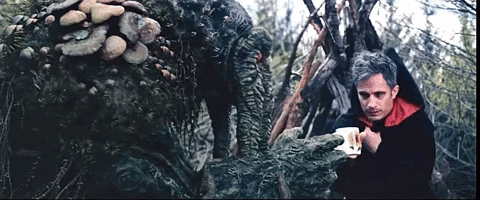
Thanks, Ted. You're a peach.
So let's look at the final scene of WBN through a queer lens. There's a needle drop, color is restored to the world, and we see Jack waking up in the woods to drink coffee, grunt at Ted, and eventually decide that sushi should happen.
(Side note: I have a whole rant about queercoding and sushi, but I cut it, so here's a gif of Aziraphale gayly eating sushi in Good Omens, which you should watch.)
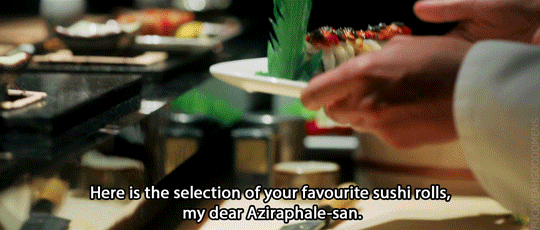
Okay, enough queer angels. Time for more queer monsters.

First things first: this scene is SO DOMESTIC, y'all. They're literally playing house in the woods, in that Ted has built Jack an adorable little house and brewed his morning coffee. The camp is littered with little domestic touches like the French press and the guitar. It's a homey, if slightly eclectic, vibe. (Where did Ted find a payphone?)
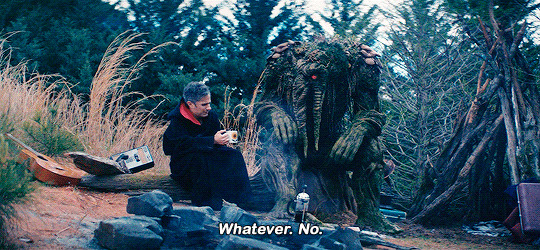
There is no explanation for these objects being there, afaik; Ted and Jack both have presumably come from some distance away, involuntarily in Ted's case, so there's no reason Ted would know the location of a well-stocked camp to put an unconscious Jack down in if Jack even set one up. Presumably the camp is Ted's work, but there's never an explanation for where he got any items other than the robe and the phonograph. (I'm particularly curious about the flower mug, personally.) Yet the objects are not remarked upon, and the entire scene is played as if this is a relatively normal morning for the two of them.
In fact, most of the mechanics of the scene are effectively those of a morning-after scene, perhaps a morning after characters fall into bed for the first time. Jack wakes up groaning, crawls out of bed to see where he is, and finds his partner has laid out something like breakfast for him and is prepared to discuss the events of the night before whenever Jack is ready.
And speaking of that discussion, we once again have displays of queercoded masculinity: Jack and Ted being physically affectionate, playful banter, and emotional vulnerability when Jack asks about Elsa. You know the drill by now. The camera pans up as "Somewhere Over The Rainbow" swells and fades out.
Wait.
Rainbow?
Let's talk about music in this film.
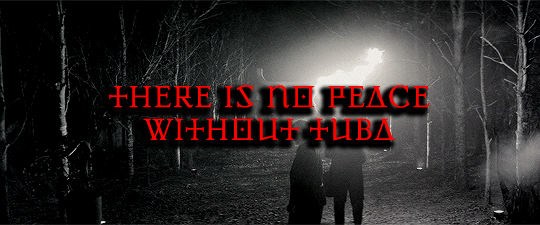
Michael Giacchino is primarily known as a composer of film music. WBN is his directorial debut. I guarantee you've heard his music before, because it's basically in every summer blockbuster franchise. If you can't get John Williams, Danny Elfman, or Hans Zimmer (all of whom are getting long in the tooth), you get Giacchino and he turns in a fucking SCORE.
Now, I am not a music person. Not at all. But even my musically illiterate ass knows that traditional film scoring derives a lot from classical music, especially Romantic composers like Beethoven. And that means LEITMOTIFS, baby!
(I learned about leitmotifs from Bugs Bunny and Star Wars. Do not be impressed.)
A leitmotif is a short musical phrase that can be used to signify a character, object, or theme in a larger work of music. For a very basic example of this, look up the Force theme from Star Wars and watch a supercut of all the times it was used to indicate that someone was using the Force. Or just watch this Sideways video about why the music in Rise of Skywalker was ass:
youtube
Anyhoo. The point of leitmotifs is to give an audience a feeling without necessarily tipping them off to exactly WHY they're having that feeling. And Giacchino LOVES his leitmotifs.
So when he uses someone else's music, he's extremely aware of the emotions that can come attached to that music. It's literally what he does.
There are two pieces of music used in WBN that Giacchino didn't write: a late 1930s recording of Vera Lynn singing "Wishing Will Make It So" and Judy Garland singing "Over The Rainbow" from The Wizard of Oz. Let's start with Vera Lynn.

Vera Lynn was an English singer most associated with big band music before and during WWII. During the war, she was known as "the Forces' sweetheart", both for her efforts to entertain the troops and for the fact that she was kind of every British fighting man's waifu. What Betty Grable's legs were to American GIs, Vera Lynn's voice was to British servicemen. She's best known for the song "We'll Meet Again", which is about exactly what it sounds like. She was a nice lady, by all accounts, and there is a ferry boat named after her now.
A Vera Lynn song about childhood and wishing is what Verussa plays in the labyrinth, apparently to annoy Elsa, who switches it off (even though that's going to inform everyone of where she is). For the purposes of queercoding, Vera Lynn is mom and apple pie, or possibly mum and fish and chips, and above all she is safe, compulsory heterosexuality. The Forces' sweetheart.
Judy Garland, on the other hand, is a queer icon.

I can't overstate what a Big Deal Judy Garland and Dorothy Gale from The Wizard of Oz are in queer culture. The themes of the story, including acceptance of the unusual and embrace of a found family (along with the sapphic elements of some of the books), resonated so deeply with queer people that for several decades, "are you a friend of Dorothy?" was code for "are you gay?" The US Navy actually launched an investigation to find the mysterious "Dorothy" who was supposedly the ringleader of all the gay sailors.
And then there's the song itself, with its theme of longing for a faraway, more colorful place where those who don't fit in at home are loved for who they are. It's, uh, pretty resonant with the queer experience.
So I now draw your attention to the phonograph. Gramophone. Record player. Whatever it's called.
In WBN, we first see the player set up in the labyrinth, presumably by Verussa or at her orders. It's playing a Vera Lynn song about childhood and wishing, which apparently annoys Elsa so much that she switches it off, thus alerting Jack to her location.
The next appearance of the player is in the camp, where it's now playing "Over the Rainbow" beside Jack as he wakes up. Ted has presumably stolen it; there's no other candidate for that, and we already saw him swipe a murder robe for Jack, so why not a record player too?
In other words, Verussa Enthusiastic Heterosexuality Bloodstone sets up the Compulsory Heterosexuality Machine, after which Elsa Ally-Coded Bloodstone turns it off in disgust, and Ted swipes it and turns it gay for Jack's benefit.
That's the coding. That's BARELY subtext. I really don't know what else to tell you. This essay started with my making an offhand joke to bluemoonperegrine about Ted and Jack being "literally friends of Dorothy" and then realizing nobody else in the conversation had noticed this stuff.
So what do we do about all this? Is WBN queer? Does all the Wolfstone stuff pale in comparison to the glory of Russallis? Am I trying to start a ship war in a fandom so small it probably wouldn't fill up Vera Lynn's namesake ferry boat?
Jack, you can answer this for me.

Nope. Not trying to start anything. I happily read Wolfstone, and technically have written some. I love all three WBN leads and am happy to enjoy them in any configuration (although my personal preference is group napping in a puppy pile, because these characters deserve naps).
I just figured it was worth documenting all this so people who haven't had the benefit of my very strange education would be better equipped to recognize (and ideally enjoy) old-style queercoding when they see it.
Wait a minute. You promised writing hacks. It's in the series title and everything.
Shit, you caught me.
Obviously, queercoding isn't a universal tool. There are plenty of storytelling contexts in which it's much better to make characters explicitly queer. Representation matters, and all that.
But sometimes you won't have time for explicit confirmation (like when your story takes place overnight and nobody really has time to play tonsil hockey). Sometimes you won't be able to include it due to outside constraints (like Disney being Disney).
And sometimes, you'll remember that there are plenty of people who can't or won't pick up explicitly queer media. Homophobic parents who won't let their kids watch Love, Simon ... but who WILL let them read your YA novel about unicorns or whatever where there are two female unicorns who are, uh, life partners. Grumpy uncles who refuse to acknowledge their nephew's boyfriend until they notice that, hey, they kinda act like Finn and Poe from that Star War. And so on. Sometimes, coded rep is the best rep you can get ... and so it's useful to have. A good toolbox has ALL the tools.
So if you're building characters for your story and don't or can't have specific queer goals, throw in a little coding. Put a rainbow T-shirt on a kid. Let two boys hold hands or have literally any feelings. Let a girl say a girl is pretty. Look up some of the older symbols for queer love and have someone growing lavender in their garden, or use newer queer symbols and have a character crack an egg in a key scene. Have a character who's content without a romantic or sexual relationship, and has an arc about something else, because aces and aros exist too.
There's a whole universe of coding out there. Go add some layers to your work.
Or better yet--see if they're there already. You might surprise yourself.
Sometimes the monster has a familiar face.

#werewolf by night#media studies and writing hacks with kat#queer theory#queer coding#queercoding#jack russell#elsa bloodstone#ted sallis#writing advice#vera lynn#judy garland#leitmotif#michael giacchino#oh god please don't kill me for this#i am rambling not trying to start a ship war#if i seem defensive it's because I'm a Peggy Carter fan and the last few years in fandom have done psychic damage#friends of dorothy#thank you for being a friend of dorothy
23 notes
·
View notes
Text
Queerwolf By Night: Queercoding, Media Literacy, and Werewolf By Night (part 2)
Welcome back to Media Studies And Writing Hacks With Kat! Part 1 is here if you missed it. We discussed queercoding: what it is, how it works, why it exists, and how it plays into the 1930s and 40s horror movies Werewolf By Night likes to reference.
Once again, the thesis I'm arguing here is that there is queercoding in WBN, and that it should be part of the discussion of the special (which I'm calling a movie or film because I think "special presentation" is dumb and this is my essay.) I am NOT arguing that WBN is explicitly queer, or that inferring heterosexuality where queercoding exists is morally wrong or even textually inaccurate.
TL;DR: you can totally still ship Jack and Elsa, I just wanna point at some metaphorical rainbows and say, "Look! Rainbows! Aren't they neat?" I personally think the queercoding adds a layer of richness to the story. I hope you get something out of it, too.
And now, allow me to introduce our starting point, the wolfman of the hour, everyone's beloved blorbo and queercoded icon: Jack Russell.

Look at this adorable protagonist, this absolute chewtoy of a human being.
He's queercoded as fuck. Not as much as Ted, but we will GET to Ted.
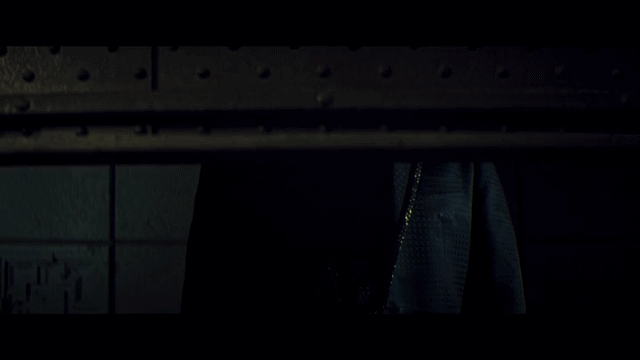
Let's begin with Jack's introduction, where he is literally revealed as the narrator speaks the phrase "the monster who finds himself among them". We join Jack as he enters an unknowingly hostile space, a building full of people who would literally mount his head on the wall if they knew who and what he really was. Jack's introduction to this world is a series of Bayeux-style tapestries showing, among other things, the gory slaughter of his kind. We see him react with a mixture of shock, queasiness, and tamped-down anxiety, which marks him as an outsider. It seems unlikely that the other hunters would be grossed out by the sight of a depiction of their literal jobs.
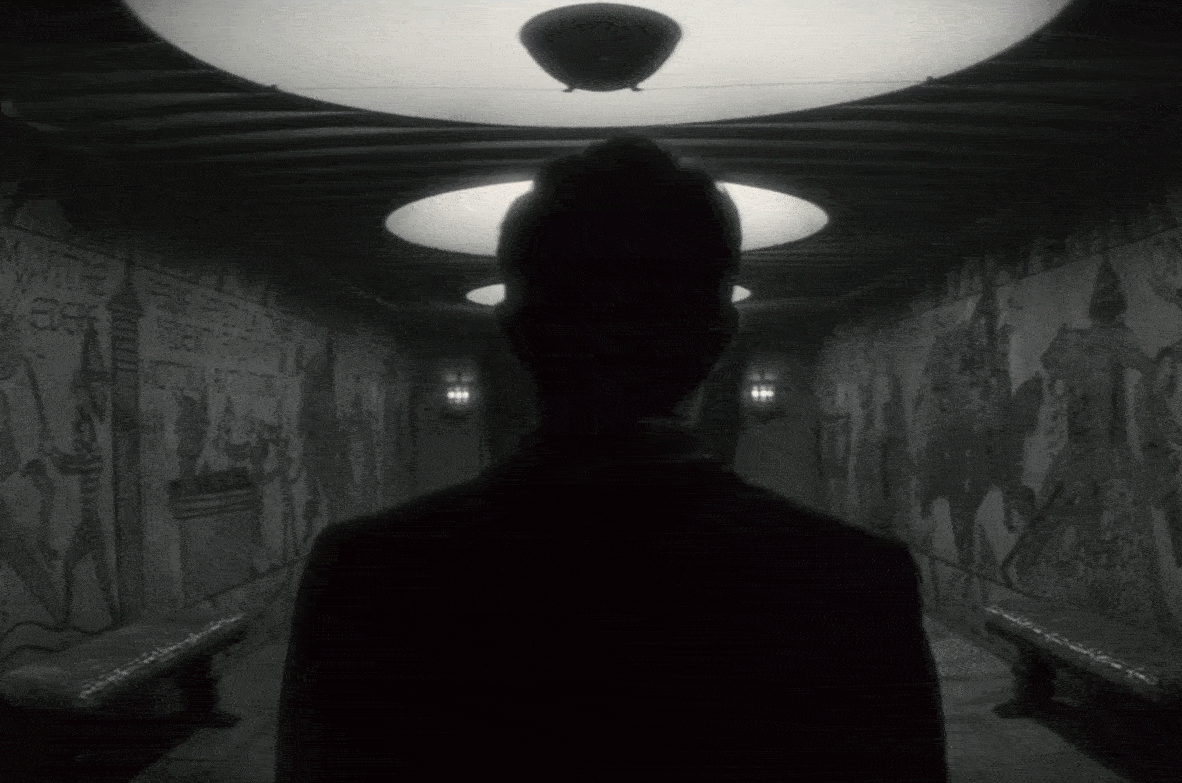
Now, outsider status alone isn't necessarily queercoding, but it often is, especially in monster movies. Jack's reaction is not dissimilar to that of a closeted person entering a homophobic church for some kind of socially expected ritual--and, indeed, Jack has come for a funeral.
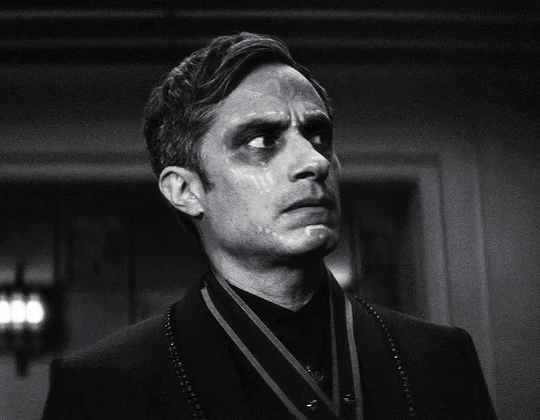
Look at that nervous glance as he walks into the room. He's not comfortable here. He knows he doesn't fit in.
This is a good time to mention Jack's outfit and the way it intersects with what we see of hunter culture. From the leather to the weapons to the heads on the wall, the aesthetic of hunter culture in WBN is hypermasculine, almost to the point of parody. The obsession with imagery of violence and death (the paintings on the walls, the corpse animatronic, the skull bowl) and the hostility to anything perceived as feminine is marked.
Wait. Hostility to anything feminine? Yes, I said that.
There are three characters who are played by female actors: Elsa, Verussa, and ... look, the hunters HAVE names, but I'm just gonna call them Scottish Guy, Asian Guy, Black Guy, and David Bowie. So David Bowie is an adrogynous character played by a female actor who acts as our third not-exactly-a-male character, and it's interesting to me that they're taken more seriously by the other hunters than Elsa is. Elsa, by contrast, is treated with contempt by the other hunters--and the contempt is very specifically gendered. Scottish Guy calls her "lassie" when he threatens her, and Asian Guy says, "Where's the lovely lady's medallion?" with a noticeable leer. They don't take her seriously, not even after Verussa announces she's welcome to participate--and they only brighten up when Verussa reminds them that they're allowed to kill Elsa if they can. That's the response to the only unambiguously female hunter.
Now, you may point out that Verussa doesn't get nearly as much shit from the hunters, but Verussa is explicitly presenting herself as the servant (and sexual partner) of a man. She's also not competing with them for the Bloodstone, nor trying to inherit, even though presumably she has at least as good a claim as Elsa does. She's not trying to enter the hypermasculine realm of hunting, but Elsa is in it, and so Elsa is despised and Verussa is tolerated.
And then there's Jack.
Okay, time for Baby's First Queercoding Element: gender nonconformity. In general, feminine male characters and masculine female characters (something explicitly forbidden by the Hays Code, by the way) are coded as queer. A lot of gay male stereotypes are men doing "womanly" things, like cooking and wearing dresses and having sex with men. The same goes for lesbian stereotypes like short haircuts, manual labor, and having sex with women. Now, obviously ACTUAL queer expression is infinitely more complex, but stereotypes don't do infinite complexity.
So. Is Jack feminine?
Well, he's wearing a gentleman's suit, but by the standards of hunter hypermasculinity, yeah, he's pretty girly. For one thing, he's wearing that suit in a room full of people in combat gear. For another, the suit itself is full of fussy details that mark him as a man who cares a great deal about his appearance, another stereotypically feminine trait. The suit is green, a barely acceptable color in menswear, and it has glittery details like the trim on his lapels. The spinal-column tie is metal as fuck, but it's also a silk tie. He's doing the death-and-gore theme, but making it high fashion. He's even wearing makeup. Granted, it's Día de los Muertos makeup, but it's still pigment on his face for aesthetic purposes. He's also the only hunter who acknowledges, in dialogue, that he has non-white, non-USAmerican heritage--"It's to honor my ancestors." He marks himself (literally) as visibly foreign, even though denigrating foreign masculinity is a big part of American hypermasculinity. He also tries to smile at and befriend every hunter who glares at him--another stereotypically feminine trait that leads to his conversation with Scottish Guy.

Speaking of, that conversation is gay as hell. It's practically flirting, especially the part where Scottish Guy compliments Jack's makeup and then tearfully admits that hunting and living all by himself "gets lonely". And Jack makes this amazing face:
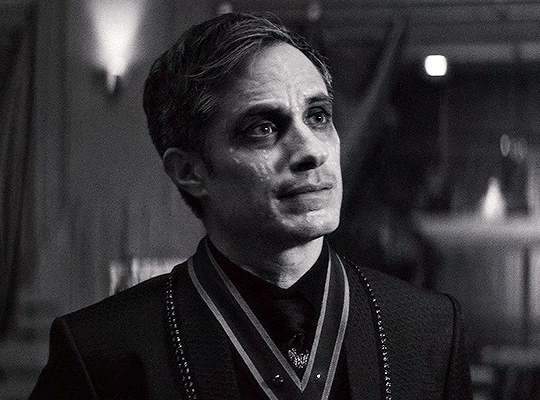
Now, this is me inferring again, but I read this face as a combination of "Aww, that's sweet of you" and "Loneliness caused by hypermasculine self-isolation? I literally have no idea what that's like, but it sounds bad, bro." Perhaps with a soupçon of "Get me out of this conversation aaaaaaa."
So the scene rolls on, and Jack continues to be Bad At Toxic Hypermasculinity. When his top kill count is mentioned, he shrugs it off rather than taking a little bow like the others do. He actually chuckles at Ulysses' joke. He seems mildly interested in Elsa rather than hostile, and amused by her snark rather than threatened by it. He shows fear and worry when he learns Ted is in peril and in pain. The guy really wears his heart on his impeccably tailored sleeve. Notably, none of these traits are bad, per se--they're just more likely to be assigned to feminine characters, and they're given to Jack.
It's important to note the impact of perspective here. Jack is our POV character. If there were to be a hunters' version of this story, Jack would be a sneaky, cowardly, vaguely effeminate villain and Elsa a traitor (or possibly a dimwitted victim seduced by Jack's charms). All of Jack's queercoding would make him a GREAT queercoded villain; it's just that here, he's the protagonist, and a deeply sympathetic one at that, so we miss some of his "unmanly" traits.
All right, let's fast-forward to the maze. We see Jack being clueless and awkward about the drawing of lots, we see some sneaking around, and then we see his first hostile encounter with Elsa, and we get this great exchange:
Jack: I suggest we just pass each other by.
Elsa: ... What?!
Jack, visibly pained by the awkwardness: I suggest we just ... pass each other by.
Jack is uncomfortable with violence. He actively avoids it, talking his way out of trouble when he can and running when he can't. Even Elsa points out how strange he is compared to other hunters, specifically because he avoids violence. He doesn't kill or even hurt anyone in his human form. He doesn't even know how his explosive works--to the point where he asks a woman if SHE knows how to work it.
I'm not saying violence is an inherently masculine trait, but the association of masculinity with a capacity for (and comfort with) violence runs deep in Western culture in general and American culture in particular. It's a huge thing in Mexican culture as well, and yet Jack is actively choosing not to participate in it. He's denying a core part of what would otherwise be his traditional gender role. He later tells Elsa that any "hunting" he does is done by "a part of me that is not me"--a part of himself that he doesn't see as himself. In his eyes, violence is not merely scary or distasteful; it's not part of him at all.
(Compare this to all the ass-kicking Elsa does.)
And then we get to Ted. Buckle up, guys.
Technically, our first introduction to Ted is a distant roar and some screaming, but the moment where we meet him is this:

A jumpscare, followed by a cuddle.
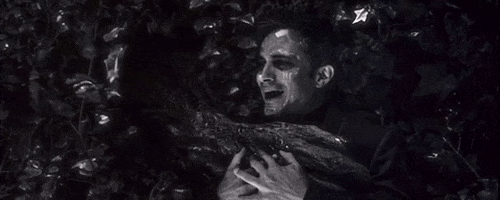
Once again, Jack wears his heart on his sleeve, but more importantly, let me draw your attention to the juxtaposition of Ted's scary grab and Jack's excited snuggling. This relationship is introduced as something scary before being revealed as something sweet--and "scary" is a good description of the portrayal of queercoded couples (who are, remember, usually villains) in classic cinema. All the cinematic language around Ted right up until the grab is telling us to be afraid of him--and then our cinnamon roll of a protagonist starts petting him and greeting him and asking if he's okay. Ted is monstrous and inhuman ... right up until we see him receive affection from another man.
We don't get clear details of Jack's relationship with Ted, but we know that it's a big deal to them--after all, Jack is risking his own life to save the big guy. Jack also describes Ted as "family" and, with a fond eyeroll, a "pain in the ass". Jack implies that he no longer has contact with his family of origin, a common experience for many queer people who are shunned for leaving the closet, but Ted slots neatly into the category of found family. Ted is also, notably, the only close relationship Jack is seen to have, just as Jack is the only close connection Ted is seen to have. The two are physically affectionate (again, cuddling) and emotionally vulnerable in their conversations.
And Elsa, the outsider to their relationship, finds the whole thing bizarre, right down to Ted's name.
Speaking of Elsa, let's talk about Jack's behavior in the crypt and the cage.
In the crypt, Jack displays compassion for someone who has largely been hostile to him (he REALLY wants to fix Elsa's leg), absolute delight when he receives the tiniest signal that she might be sympathetic to him ("It's not in your DNA, then?") and remarkable emotional intelligence (see his speech about families). He also, notably, doesn't hit on Elsa or indicate any sexual interest in her.
He also makes this terrific face when he's handed a skull:
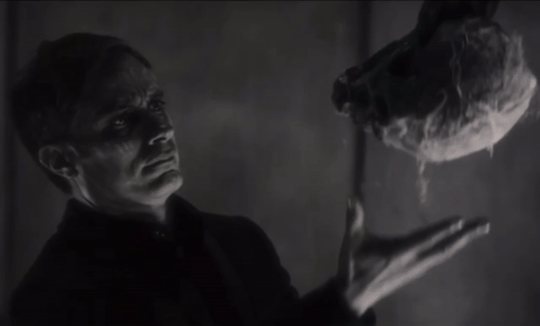
Oh, yeah, that's a big, scary hunter there.
Now, the cage. Jack's response to being put in the cage (and stripped of his jacket, interestingly--little bit of dehumanization there, perhaps) is recognition, followed by attempts at reassuring Elsa, followed by panic. He's arguably more upset than Elsa is, and Elsa thinks she's about to be torn to shreds.

At two points in this story, Jack Russell finds himself trapped in a small space with a beautiful woman and more or less immediately freaks out. It's not the most heterosexual pattern. In fact, it's got strong thematic overtones of queer men being forced into straight relationships by their families, their work, or their society. In a culture that entwines sex and violence, the fact that he's delighted to be grabbed by a male swamp monster but begs for death rather than symbolically do a sex with a woman is noteworthy.
"Symbolically do a sex"? Yeah, the only times the film frames Elsa as anything like a sexual object are the transformation sequence, which is a visual callback to classic sexualized scream queens of yore with her literally in Jack's shadow, and the face-touching scene, where Jack straddles her, their faces almost touch, and then he flees and she sits up with her hair mussed in a dreamy, almost post-orgasmic way.
Michael Giacchino doesn't eroticize violence MUCH, but he's fairly classy about it when he does.
"But wait!" I hear you saying. "What about the sniffing scene? Isn't that eroticized? And it's between Jack and Elsa! Checkmate, liberals!"
First of all, how dare you call me a liberal when my preferred political descriptor is "chaotic good". And second of all ... well, you're HALF right. It IS eroticized...but not because of anything Laura Donnelly or Gael Garcia Bernal is directly doing.
Go watch Elsa's body language during the scene. It's awkward as fuck. She's curled in a ball, knees and elbows out, letting Jack pull on her arm and sniff her hair but not really participating. There's no indication that she wants to be doing this, or even knows what "this" is.
Gael is making a little more of an erotic show about it; in fact, the intensity of his sniffing would probably be an indicator of sexual desire--if he weren't CRYING WHILE HE DOES IT. That's why his voice breaks on "Once."
These are both excellent actors, making very intentional choices with their voices and bodies. They're playing the scene as something that COULD be sexy IF THEY WEREN'T BEING FORCED TO DO IT.
Seriously. There's enough fanfic now that we've all read Jack giving Elsa a leisurely, consensual sniff. You can't tell me Gael and Laura couldn't have made that happen. This is not sexy sniffing. This is angst sniffing. It's just angst sniffing between two beautiful, sympathetic characters who genuinely don't want to hurt each other. It could have been acted and shot in a much sexier way, but it wasn't.
It's also worth noting one last category of queercoding that WBN plays with a lot: dehumanization. A lot of those classic movies played their queercoded characters as specifically less than human, visually aligning them with disliked animals like rats or wolves and often making them literally less human as the story progressed. Even after the Hays Code, monstrous and inhuman queers became a staple of horror movies, especially in the 1980s and 90s as the AIDS crisis convinced a lot of conservative America that LGBTQ people were literal plague rats. There were proposals to tattoo HIV-positive people to identify them, to round them up into camps, to shut HIV-positive kids out of schools because those kids were implicitly queer and therefore not deserving of human rights like an education.
WBN, with its werewolf POV, pushes back on this trope in some specific ways. Jack's line about being "still a human" is an obvious one, as well as his explanation of "systems" to keep other people safe. (It was common during the AIDS crisis for queer people to be fired from their jobs if they were outed because they were considered an AIDS risk to their coworkers--even if they were, say, an office worker who didn't have any contact with other people's bodily fluids. There were conspiracy theories about AIDS spreading through shared soda cans. Those paper seat protectors in public bathrooms came about because of fears that AIDS could spread via toilet seats. So imagine a gay man trying to explain that he's not a threat to his officemates, and you'll see the parallels to Jack trying to reassure Elsa.)
Most notable, however, is how Elsa survives the wolf. She's safe because she maintains eye contact (implicitly acknowledging her and Jack's shared humanity--she literally refuses to stop seeing him) and because he remembers her scent (she becomes a part of his world as he becomes part of hers). Elsa is rewarded, both with her life and with her inheritance, for treating Jack and Ted like human beings when the world around her regards them as abominations.
Elsa is an ally. She's ally-coded. She can also be read as a love interest for Jack, but she consistently acts in support of his relationship with Ted as well.
In Part 3, we're going to talk about the crowning moment of queercoding in WBN. That's right--it's time to learn about coffee in the woods, the gay jukebox, and the Friends of Dorothy.
#werewolf by night#werewolf by night meta#queer coding#jack russell#ted sallis#elsa bloodstone#attempts at formal analysis#what am i even doing#i hope someone actually likes this#jfc this is so much longer than i planned#nobody get mad at me please#i am literally just pointing at the thing we all like and saying “look a good bit”#long post#media studies and writing hacks with kat
18 notes
·
View notes